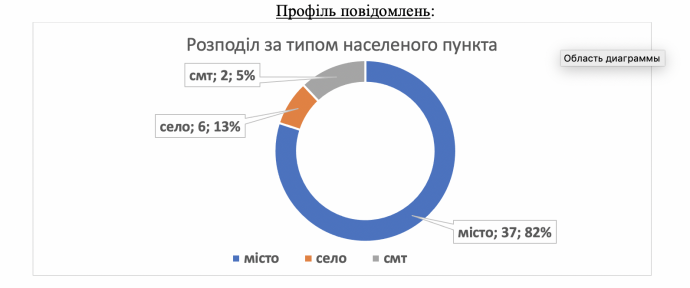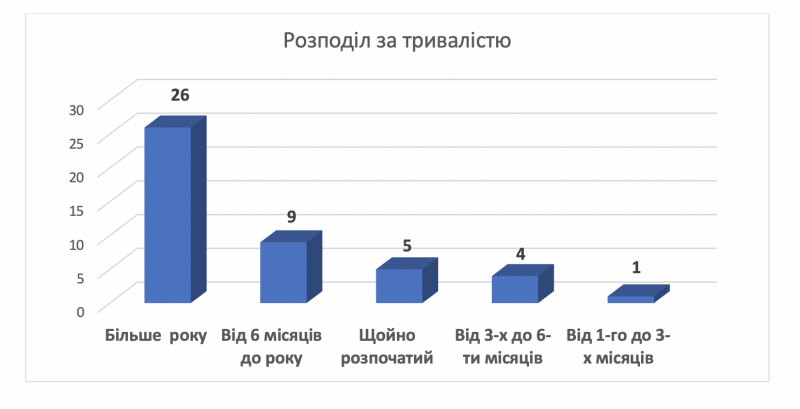Conflict analysis in the third geographical cluster.

What happened to the conflicts in these communities, a small analytical cross-section for the period April-July of this year.
During this period, GISMAOVC analysts monitored local media and social networks, assessed the opinion of representatives of local communities during personal communication, and based on the results of such monitoring, 45 messages of a problematic and conflict nature were identified.

Areas where conflicts/problems have been identified.
Most often, the following areas were represented: medicine; transport and communications; education; housing and communal services; nature management and ecology; creation and assistance to strengthen the capacity of territorial communities; human life safety and law enforcement agencies; social and pension provision, provision of social services (benefits, payments, granting the status of persons with disabilities and IDPs, etc.); information and communication policy; culture.
The analysis of 39 messages that are plotted on the GISMAOVK map was carried out. Based on the results of the analysis, 31 comments were submitted on the current state of conflicts and problems, namely::
- Confrontation between Rubizhne activists and representatives of local authorities
- The problem of quality of Transportation on the Route Lisichansk-Severodonetsk
- Conflict between the regional authorities and the public regarding the preservation of the Belgian heritage of Lisichansk
- Gusts, freezing of the heating system. Conflict with KP «Zhilservis » Rassvet"
- Confrontation between Rubizhne activists and representatives of local authorities
- Disconnection of water supply to domestic consumers in Lisichansk
- The problem of pollution of the territory around lakes in Severodonetsk
- Inability of residents of Sirotino village affected by fires to restore their homes before the onset of frost
- Disconnection of water supply to domestic consumers in Lisichansk
- Environmental disaster caused by the activities of metallurgical plants in Mariupol
- Conflict over dismissal of employees of social facilities in Chasov Yar
- Environmental disaster caused by the activities of metallurgical plants in Mariupol
- Environmental issues of Melovoe village
- Conflict between the regional authorities and the public regarding the preservation of the Belgian heritage of Lisichansk
- Dissatisfaction of some residents with the project «detailed plan of the territory of 81 microdistricts of the city of Severodonetsk
- Environmental disaster caused by the activities of metallurgical plants in Mariupol
- Cutting down young green trees in Mariupol
- Environmental disaster caused by the activities of metallurgical plants in Mariupol
- Threat of an environmental catastrophe in connection with shale gas production in Svyatogorsk
- Environmental disaster caused by the activities of metallurgical plants in Mariupol
- Cutting down young green trees in Mariupol
- Dissatisfaction with the urban population regarding the construction of McDonalds on Grecheskaya Square in Mariupol
- Environmental disaster caused by the activities of metallurgical plants in Mariupol
- Conflict between the regional authorities and the public regarding the preservation of the Belgian heritage of Lisichansk
- Dissatisfaction of some residents with the project „detailed plan of the territory of 81 microdistricts of the city of Severodonetsk
- Ugledar, miners ' conflict — Surgaya mine
- Environmental disaster caused by the activities of metallurgical plants in Mariupol
- Miners ' protest action in Mirnograd
- Inability of residents of Sirotino village affected by fires to restore their homes before the onset of frost
- Environmental disaster caused by the activities of metallurgical plants in Mariupol
- Conflict of miners-St. Matrona Moskovskaya mine in Toretsk
The susceptibility to conflicts was assessed in six communities – Milovskaya AH (Melovoe village), Shchastya AH (Shchastya village), Stanichno-Luganskaya AH (Stanytsia Luhanska village), Lisichanskaya AH (Lisichansk), Severodonetsk, starobilsk.
In order to increase confidence in the geographic information system for monitoring, analyzing, evaluating and resolving conflicts, analysts participate in focus group studies and face-to-face meetings with GISMAOVC Information Message providers in communities.
GISMAOVC analysts constantly participate in weekly expert meetings to analyze processes related to changes and the dynamics of conflict development.
Despite the situation in the country related to the COVID-19 pandemic and climate problems, there are no non-standard situations or any obstacles to performing analytical work within the framework of GISMAOVC.
A team of GISMAOVK analysts.

